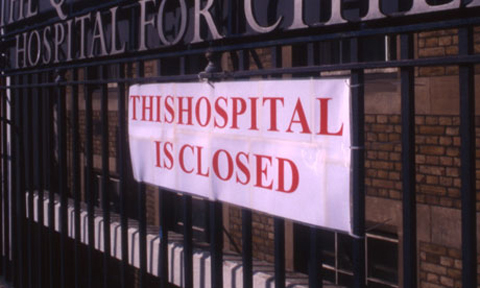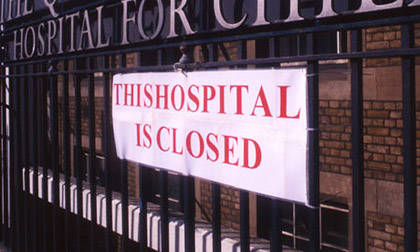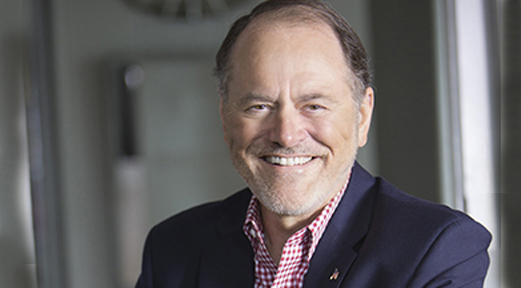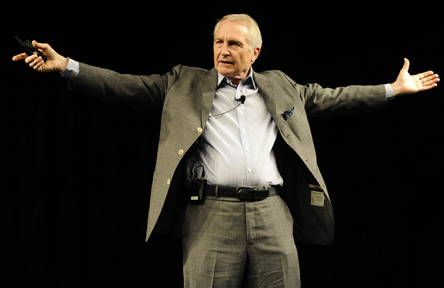
The Closing of Hospitals
While much is uncertain in the era of health reform, the number of hospitals is clearly going to shrink, perhaps by a lot. A healthcare system that tolerated the inefficiency of having two mediocre 125-bed hospitals in adjacent towns will no longer do so: one 200-bed hospital will be left standing when the dust settles. If that.
The betting is that 10-20% of hospital bed capacity will be taken out of the system in the next few years. It could be even more, depending on the answers to several questions. Will electronic monitoring and telemedicine allow increasing numbers of sick patients to be cared for at home or in sub-acute settings? Will payments for non-hospital care systems (home care, SNFs) be enough to expand their capacity to care for acutely ill patients? Will ACOs, bundling, and other similar interventions truly flourish? Will a shift to population health and a new focus on wellness make a dent in the prevalence of chronic disease? These are just some of the known unknowns.
What does this mean for hospitalists? Obviously, if you happen to work at a hospital that closes, you may be out of a job. But pick up a copy of the NEJM or the Journal of Hospital Medicine: there are still far more openings for hospitalists than there are people to fill them. Although I’m expecting few if any unemployed hospitalists, there will be change: hospitalists will be working in fewer buildings, they’ll be working a bit harder, and the hospitals that do stay open will be more efficient.
Out of the ferment will come new opportunities for hospitalists. I’m on the board of IPC, the largest hospitalist company in the U.S. Several years ago, the company recognized that many patients who used to be in the hospital were now in sub-acute settings. Today, nearly one-third of IPC’s clinicians work in SNFs and long-term care facilities. I suspect that some of the hospitalists displaced by hospital closures will find work in these kinds of settings – and these will not be your father’s SNFs. The level of patient acuity may be similar to that of hospitals a decade ago.
In addition to closures, we’ll see plenty of mergers and affiliation. I’m also on the board of Salem Hospital in Oregon, a terrific, mid-sized hospital that is – to a large degree – the only game in town for Salem, a mid-sized city with a population of about 160,000. The hospital is well run: we have had computerized order entry for a decade, have been running a robust physician leadership academy since 2009, and adopted Lean well before it became fashionable. The hospital enjoys a healthy bottom line and significant reserves. Yet in the current environment, it was the judgment of the leadership and the board of directors that we could not go it alone. We announced last month that we are in talks with Oregon Health Sciences University (OHSU) to affiliate.
And at home, UCSF just merged our children’s hospital with Oakland’s. For those of us working in or running hospitalist programs, these new relationships are likely to mean significant change. In a three-hospital system with 100 hospitalists, I doubt there will be three different leaders and three independent programs. Sorting out the relationships, the money, the schedules, and the culture will offer a new and complex set of challenges to those of us who have had the luxury of managing a single program in a single building.
Hospitalist Workload and Support
Last month in JAMA Internal Medicine, researchers at Christiana Health in Wilmington, Delaware correlated hospitalist workload with both quality and efficiency outcomes. Their findings were striking: when hospitalists ran censuses of more than 15 patients, for each additional patient costs per case went up by $262. These increases varied a bit depending on how full the hospital was, but no matter how full the building, the relationship held.
As I noted in an accompanying editorial, this study is important for several reasons. First, it illustrates a point that I’ve made since the early days of the field (but without much evidence to support it, until now): there must be a workload above which some of the advantages of the hospitalist model – on-site presence, constant availability – begin to erode. Just think, if you’re managing 20 patients and you spend 15 minutes seeing (and charting on) each patient, you won’t get to your last patient till well after noon. And if a couple of patients get sick… well, the ballgame is over. I’ve frequently counseled hospitals that were considering supporting hospitalist programs that it might be in their financial interest (i.e., there might be an ROI) to do so if their dollars helped the physicians maintain a manageable census – independent of any advantages gained in recruiting, retention, and allowing hospitalists time to work on systems improvement.
The reason this is important is that, as hospital budgets tighten, hospital support payments to hospitalists will come under increased scrutiny. In primary care, the lack of evidence that bad things happen (other than physician burnout and patient unhappiness) when visits shorten to 14 minutes meant that there were no compelling counterarguments to briefer visits. For hospitalists, the Christiana study creates such a counter argument.
Will this mean that hospitalist support payments will go unchallenged? Hell, no. IPC has grown to become the biggest player in the hospitalist staffing business in part because the majority of its programs do not receive significant hospital support (let me remind you again of my conflict here). They do this by running programs efficiently, by billing effectively, and by employing a schedule that has people work more days per year than hospitalists do under the more common and very popular 7-days-on/7-days-off structure. Although IPC hospitalists have had a reputation of carrying large caseloads, I’ve seen the data and I know that their average census is, in fact, about 15.
The point here is that, just as hospitalists took over the world of hospital care because they demonstrated that they could provide high-quality care at a lower cost, the increasing financial pressures that hospitals are under will create, in turn, pressures on hospitalist programs to achieve quality, safety, patient satisfaction, and efficiency outcomes at the lowest possible cost to the hospital. In this environment, every program needs to be looking at its caseload and outcomes to defend any support payments it gets. The Christiana study provides a strong argument that those support payments may be cost effective if they allow a hospitalist group to maintain market-appropriate salaries while keeping volumes manageable.
Also, the paper was important in that it is one of the first to look at the relationship between physician volume and outcomes, in any specialty. Such studies are familiar in nursing, and have led to major policy changes. In California, for example, nurse-to-patient ratios are mandated to be no more than 1:5 on med-surg floors, in part based on such studies. But physicians have always had a Super Doc attitude: That they could see any number of patients and nothing bad happens. This defies the laws of both physics and physiology, and I hope the Christiana paper ushers in studies of other fields asking the question: what physician volume maximizes value.
There is another point about hospitalist organization that is worth paying attention to. The latest American Hospital Association data show that there are more than 40,000 hospitalists in the U.S. As the fastest growing specialty in modern medical history, it’s easy to think that the field has “won” and is safe from competitive threats. But with so much change afoot, such thinking is dangerous.
My friend David Meltzer of the University of Chicago is testing a model of comprehensive care – in which a select group of high risk, frequently admitted patients is cared for by a single physician in both the inpatient and outpatient setting. Sound familiar? It should: that’s the old system! Meltzer’s early results, presented at SHM and elsewhere, are promising.
Some people have asked me, given my advocacy for the hospitalist field, whether this bothers me. If it did, I’d be a hypocrite. The reason the hospitalist field thrived was that it demonstrated that it delivered better value than traditional models. But it is a completely plausible hypothesis that – for a subset of patients – the continuity of the old model might win out, particularly if these comprehensive docs are advantaged by the on-site presence of hospitalists (for nighttime coverage or if their patients crump acutely) and by the latter’s work improving the system of care.
So I applaud David and his colleagues for testing this model in the 5-10% of patients who might benefit from it. We must always stay open to the idea that there are better ways of doing things.

















